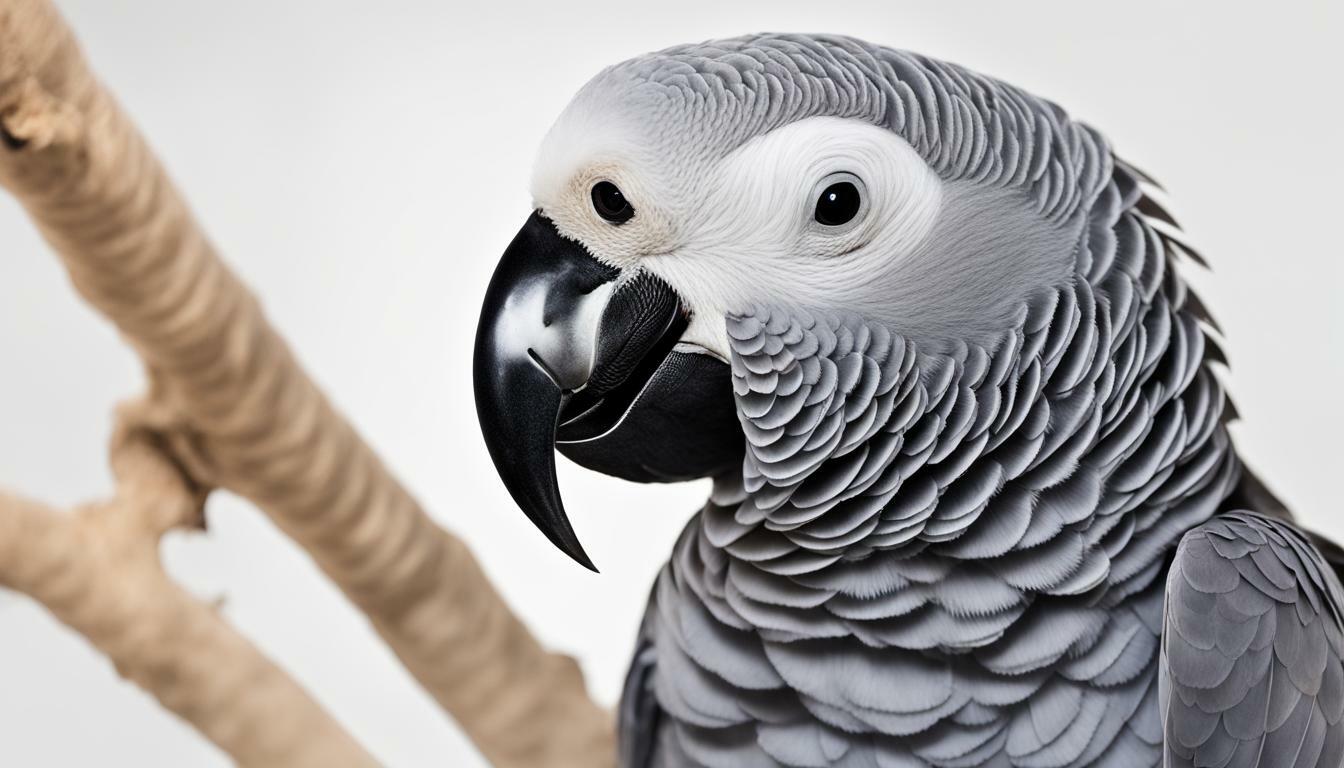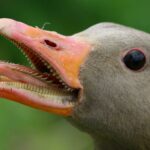As a bird owner, you may wonder if African Grey Parrots are loud or quiet birds. Understanding their noise levels and vocalizations can help you prepare for their behavior and manage their noise. In this section, we will explore whether African Grey Parrots are loud and their sound behavior.
- Are African Grey Parrots Loud?
- What are African Grey Parrot noise levels?
- What are African Grey Parrot vocalizations?
Key Takeaways:
- African Grey Parrots are known for their intelligence and ability to mimic human speech.
- Their noise levels can vary, but they are generally considered to be loud birds.
- African Grey Parrots use vocalizations to communicate and convey messages.
Understanding African Grey Parrot Noise Levels
If you’re considering an African Grey Parrot as a pet, one common question you may have is whether they are loud birds. The answer is that it depends on the situation and context.
On average, African Grey Parrots have sound levels of approximately 85 decibels, which is equivalent to the noise level of a dishwasher or heavy traffic. However, they can sometimes reach up to 100 decibels when excited or alarmed, which is comparable to the noise level of a chainsaw.
It’s also important to note that African Grey Parrots are intelligent and social birds that require mental stimulation and interaction. Lack of attention or stimulation can lead to boredom and excessive vocalization, which can be interpreted as noise.
Factors that can influence the noise levels of African Grey Parrots include their environment, health, emotional state, and level of socialization. It’s essential to provide them with a comfortable and stimulating environment that meets their physical and mental needs to avoid excessive vocalization.
Overall, while African Grey Parrots can be loud at times, their noise levels are manageable with proper care and attention. Understanding their sound levels, vocalizations, and factors that influence their noise can help you better manage their behavior and create a harmonious living environment.
African Grey Parrots Vocalizations and Communication
African Grey Parrots are highly skilled vocal communicators. In fact, they are renowned for their ability to mimic human speech accurately. They use their vocalizations to convey a range of messages, including warning signals, greetings, and mating calls.
As social creatures, African Grey Parrots rely heavily on communication to interact with each other and their environment. They use a variety of sounds to express themselves, including chirps, whistles, squawks, and screams. These sounds can vary in tone, volume, and duration, depending on the situation.
One of the most fascinating aspects of African Grey Parrot vocalizations is their ability to associate specific sounds with objects or events. For example, they can learn to associate the sound of a doorbell with the arrival of a visitor or the sound of a microwave with the preparation of food. This demonstrates their advanced cognitive abilities and intelligence.
It is important to note that African Grey Parrots can be noisy as they communicate with each other. Some of their vocalizations can be quite loud and may seem excessive, especially in small living spaces. However, it is essential to understand that vocalizations are a natural part of their behavior and should not be discouraged entirely.
The best way to manage African Grey Parrot noise is to provide them with adequate opportunities to communicate and interact with their environment. Encourage healthy vocalizations and provide plenty of toys and enrichment activities to keep them engaged and occupied. Additionally, training and socialization can help minimize excessive vocalization.
Factors That Influence African Grey Parrot Noise
When considering the question, “Are African Grey Parrots noisy?” it is important to understand that their noise levels may vary based on several factors. By understanding these factors, you can better manage your parrot’s noise levels.
- Environmental Stimuli: Loud or sudden sounds in the environment, such as sirens or construction noise, may cause your parrot to become more vocal.
- Attention Seeking: Like many other parrots, African Grey Parrots may make noise to get attention from their owners.
- Mimicry: African Grey Parrots are well-known for their ability to mimic sounds they hear in their environment, including human speech and other noises.
- Socialization: African Grey Parrots are highly social creatures, and may become louder when they are in the presence of other birds or their owners.
By understanding these factors, you can take steps to minimize or prevent your parrot from becoming too noisy. For example, providing your parrot with plenty of socialization and attention can help prevent excessive noise due to attention seeking. Similarly, ensuring your bird’s environment is quiet and free from sudden noises can help reduce the likelihood of them becoming more vocal.
Common African Grey Parrot Sounds
African Grey Parrots are known for their vocalizations, which can be quite varied and complex. They use a range of sounds to communicate with their environment and other birds.
African Grey Parrot Squawking
Squawking is a common sound produced by African Grey Parrots. This is a loud, harsh vocalization that can be heard from a distance. It is often used to communicate distress, protest, anger, or simply to grab attention.
Owners can help manage squawking by identifying the cause of the behavior and providing the parrot with the necessary stimulation. This can include toys, social interaction, or physical activity.
African Grey Parrot Screeching
Screeching is another loud, high-pitched sound that African Grey Parrots produce. This sound is often used to communicate excitement, fear, or frustration. It can be especially intense during mating season or when the parrot is feeling threatened.
Owners can try to minimize screeching by creating a relaxing environment and avoiding situations that trigger the behavior. They can also provide the parrot with plenty of mental and physical stimulation to help reduce stress levels.
Understanding these sounds is essential for anyone owning an African Grey Parrot, as it can help them identify the bird’s mood and respond accordingly. By providing for the parrot’s needs and creating a supportive environment, owners can help manage their parrot’s vocalizations and create a peaceful living space for everyone.
Tips for Managing African Grey Parrot Noise
If you’re a proud owner of an African Grey Parrot, you know that they can be noisy birds. While their vocalizations are a natural part of their behavior, excessive noise levels can be disruptive, both to the bird and to their human companions. Here are some tips for managing African Grey Parrot volume:
- Establish a routine: African Grey Parrots thrive on routine, and having a set schedule for socialization, feeding, and playtime can help reduce their stress levels and prevent excessive noise.
- Provide mental stimulation: These birds are highly intelligent and need mental stimulation to prevent boredom and excessive noise. Invest in toys, puzzles, and games that can keep them entertained and engaged.
- Introduce noise-cancelling devices: If you live in a busy or noisy environment, noise-cancelling devices can help reduce the level of external noise that can trigger excessive vocalizations.
- Train your parrot: African Grey Parrots can be trained to respond to cues and commands, which can help reduce their noise levels. Positive reinforcement training can also strengthen your bond with your pet.
- Provide a cozy environment: African Grey Parrots need a quiet and cozy environment to sleep. A comfortable and secure sleeping area can help reduce the likelihood of overnight noise.
By implementing these strategies, you can create a harmonious living environment for you and your African Grey Parrot. Remember, these birds are highly social and need attention and interaction. Be patient and consistent in your training and care, and you can enjoy a happy and healthy relationship with your feathered friend.
What Type of Bird is Known for Performing a Ritualized Mating Dance?
The mesmerizing birds mating dance is known to be performed by the Sage Grouse. This unique bird species exhibits an elaborate courtship ritual, where males gather in mating grounds to display their beautiful feathered plumage and perform intricate dances to attract potential mates. This elaborate ritual is a remarkable spectacle of nature, showcasing the lengths some species go to in search of a partner.
How Do Researchers Track and Study the Vocalizations of African Grey Parrots in the Wild?
Researchers use various methods for tracking wild tiger populations in order to study their vocalizations. For African Grey Parrots, similar approaches are employed. Primarily, researchers utilize acoustic monitoring techniques, such as bioacoustic recorders, to capture and study the vocalizations of these parrots in their natural habitats. This allows for a better understanding of their behavior, vocal repertoire, and communication patterns, aiding conservation efforts for the species.
Conclusion
As you have learned, African Grey Parrots can be quite noisy, especially during certain circumstances. Their sound levels can reach up to 106 decibels, similar to that of a chainsaw or a car horn. However, it’s important to note that not all African Grey Parrots are equally loud, and their noise levels can be influenced by a variety of factors, including their environment, diet, and social interactions.
Despite their loud nature, African Grey Parrots are also known for their remarkable vocalizations and communication abilities. They are capable of mimicking human speech and creating a wide range of sounds, from whistles and chirps to squawks and screeches.
Tips for Managing African Grey Parrot Noise
If you own an African Grey Parrot and are struggling with their noise levels, there are a few strategies you can try. Firstly, ensure that your parrot is getting enough mental and physical stimulation, as boredom can lead to excessive vocalizations. Providing them with toys, puzzles, and playtime can help alleviate their restlessness.
Additionally, consider creating a designated area for your parrot that is away from high-traffic zones, such as the living room or kitchen. This can help reduce their exposure to stimuli that may trigger loud behavior. Finally, reward your parrot for quiet behavior to reinforce positive habits and discourage excessive noise-making.
By implementing these tips and strategies, you can help manage your African Grey Parrot’s noise levels and create a peaceful and enjoyable living environment for both you and your feathered friend.











